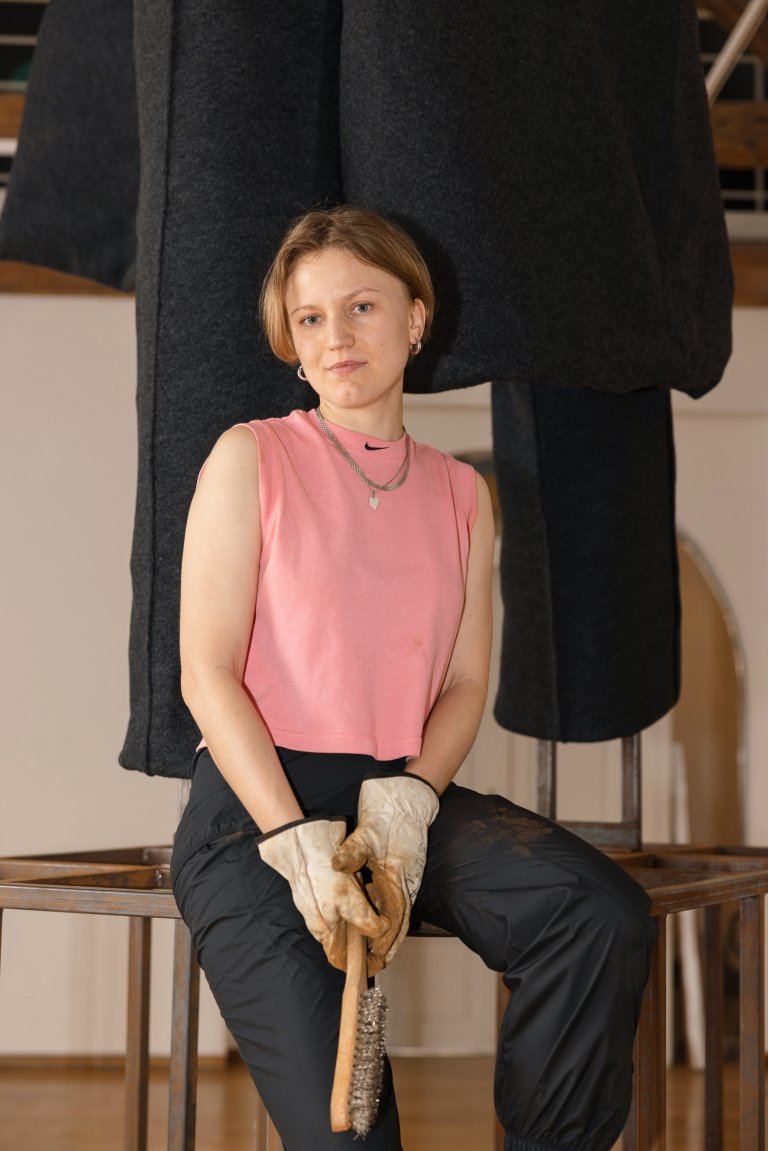*1989 (Belarus)
education: Belarusian State Academy of Arts (Minsk), Academy of Fine Arts (Wrocław)
lives and works in Wrocław, Poland
Ala Savashevich utilizes visual media—primarily objects and sculptures, but also video and performance—to comment on and critique both past and present political and social situations. Whether addressing the realities of her native Belarus, the entire Eastern Bloc, or, by extension, all countries affected by colonialism, her work speaks to collective memory, its censorship, erasure, or updating. Thematically, her work follows Eastern European artists who emerged significantly after the fall of the Iron Curtain, expressing from their own experiences, yet with a distance and newfound freedom, the realities of totalitarian life. However, due to her unique position as a political emigrant, her creative language remains wholly authentic and relevant.
Ghost, 2017
It has been seven years since the realization of my work “Ghost,” and it seemed to me that the topic of monuments had been exhausted. However, various events show that the issue of monuments as objects of memory has not been fully resolved, neither in the Middle East nor in Central Europe. Everything continues to acquire new functions, contexts, and properties. As I continued to work on the theme of memory and its consequences, I observed that the slogan “Monument” evokes various feelings and memories from history. We try to deal with difficult topics from the past, sometimes focusing on them intensely. Often, we want to erase something from the past, forget it, and not return to it, but instead, we accumulate resentment, which generates even greater problems. It is difficult for us to engage in dialogue on this topic; we do not listen to the voices of others and do not give the other side the opportunity to express themselves. And then we shape new content according to old patterns.
“Ghost” is an interpretation of my monument and my attitude towards monuments, but it is also a reference to the existing monument of Lenin from my hometown of Stolin in Belarus. My perception of Lenin (with an awareness of history and his role in it) is completely different from that of the older generation. I grew up in a different time, and these monuments always seemed more abstract to me than to those who grew up in the Soviet Union.
The starting point of my work was the monument as a shape, an artistic form, and only then as the person it represents, in this case, Lenin. However, my work is not a monument in the standard sense of the word. It depicts the incorporeal Ghost – a spirit walking through Europe; once a living person evoking genuine fear, now only an image of history and memory that evokes general antipathy and resentment – akin to the ghost of Hamlet’s father, as Boris Groys writes in “The Communist Postscript.”
Currently, many people perceive monuments as burdens permanently inscribed in the urban landscape or do not perceive them as the background of everyday activities. Similarly, political conflicts that shaped and continue to shape our cities remain unnoticed in everyday life, yet their ghost still hangs in the air.
In order to “see” the monument again, to “rediscover” its history, I decided to focus on its clothing and restore its original properties – sculptural material (stone) once again became fabric – felt. The figure inside the fabric disappears as something mythical and mysterious. And when the figure is absent, its history fades away as well. Only the impersonal clothing remains – an empty shell. Everything that could be told about the figure is now told by the material – the suit and coat. “Ghost” on the pedestal is mounted on wheels, making it mobile and easily movable. In fact, it is the opposite of a stationary, monolithic monument, which by definition is permanently assigned to a specific place.
Monuments were built to live forever, but they age and depart from everyday life, sometimes of their own accord, and sometimes by compulsion. Today, when I look back on how “Ghost” has changed over the years, I also have many questions. The work does not speak of the past but of the present. How to work with history and its remnants today? We all want change and are waiting for it, but our views on how to achieve it differ too much. It will be difficult to change anything until we come to a common agreement.
